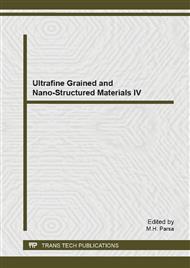p.482
p.487
p.492
p.497
p.505
p.510
p.515
p.520
p.525
Effect of SiC Nanoparticles Content and Milling Time on the Characteristics of Al/SiC Nanocomposite Powders Produced via Mechanical Milling
Abstract:
In the present study high energy ball milling was utilized to produce aluminum (Al-6061) matrix nanocomposite powders reinforced with nanosilicon carbide (SiC) particles. The starting materials containing different percentages (1,3 or 5 wt.%) of nanoSiC particles (25-50 nm) and Al (38-63 μm) were co-milled for different times (16, 20, 24 h) to achieve nanocomposite powders. The crystal size of powders were evaluated by quantitative XRD analysis. Laser particle size analysis was used to evaluate the size of powders during milling. The microstructure of powders and their microhardness values were evaluated by Scanning Electron Microscopy (SEM) and a microhardness tester respectively. The results indicated that the crystal size of the matrix alloy decreased by milling time. The increased SiC content up to 3% resulted in increased microhardness of the powders. However, further increase of SiC to 5% resulted in decreased microhardness due to agglomeration. It was concluded that the maximum microhardness together with a uniform distribution of SiC particles within the matrix alloy was obtained after 20 h milling of powder mixture containing 3% of SiC nanoparticles.
Info:
Periodical:
Pages:
505-509
Citation:
Online since:
November 2013
Authors:
Price:
Сopyright:
© 2014 Trans Tech Publications Ltd. All Rights Reserved
Share:
Citation:


